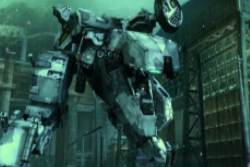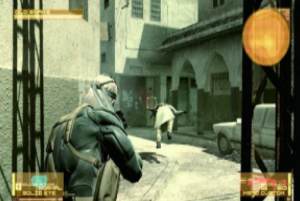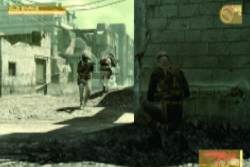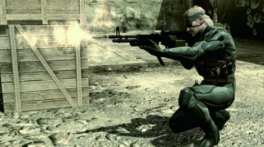| |
 Metal
Gear Solid 4: Guns of the Patriots (Playstation 3) Metal
Gear Solid 4: Guns of the Patriots (Playstation 3)
Bringing Hideo Kojima's seminal stealth-action series to a brilliant
close, Solid Snake's fourth adventure marks an enormously satisfying
finale. With an older protagonist hobbled by age, MGS 4 takes place inside
a futuristic battle field and the consequences caused by high-tech
gadgets, nano-technology and world-wide control on the minds of soldiers.
Its gameplay stays true to the MGS formula for the most part, with a new
Octo-camo suit and the MKII robot adding some flash. Guns of the Patriots'
engrossing storyline, fleshed out characters, elaborate cinemas and,
startlingly realistic environments just scratch the surface of MGS4's
technical achievements. Hideo Kojima's farewell is definitely one of the
most technically impressive titles on the PS3 to date, with brilliant,
innovative design evident in almost every aspect of its production. |
| Metal
Gear Solid 4's initial stages are probably designed to be a little off
putting for veteran players. Instead of the young, seemingly omnipotent
Snake players are accustomed to, Guns of the Patriot presents a
significantly older, nearly worn-out hero who's showing the affects of
age. He can't move quite as fast as he used to, and Snake's maneuvers
aren't quite as effective as they used to be. Unlike previous MGS titles,
Snake takes quite a hit when there's an alert. Instead of bouncing right
back after each enemy encounter, he needs to take a breather and wait for
his stress gauge to lower. When he's stressed, he isn't nearly as agile
and moves slower, making him more vulnerable to attack. However, the
effect doesn't weaken the character's appeal, and instead has the opposite
effect, giving Old Snake the immediate mantle of an underdog up against
impossible odds, complicated by his advanced age and somewhat appearance.
While you'd expect this newest installment to take place decades after the
events in MGS 2, it's only been a few years. It's kind of shocking to
discover the reasons behind his advanced age and when his motivations and
actions become clear, it makes this formerly impervious character seem all
the more sympathetic. The theme of old age and obsolescence runs through
the game fairly often and makes the plot feel more like a meditation on
mortality than a mindless gun-and-run adventure. It has the overall effect
of humanizing the experience, which allows the player to more fully
appreciate the nuance of the story and plotlines. When some of the other
returning characters encounter the prematurely aged Snake, their reactions
feel more natural, and Snake's counter reactions, despite their gruffness
shows a character still focused on the mission, and willing to sacrifice
everything for its success.
 The
futuristic battlefield Snake finds himself in is a strange one, filled
with rival factions, unaffiliated rebels and where a multinational
organization called the Patriots control everything that happens. They
have developed a highly advanced Nano-technology system that allows them
to control the moods, emotions and physical attributes of any soldier on
the battlefield, ensuring them complete control over the action of any
given conflict. They have also locked nearly every weapon in the world to
the individual soldier, and this lock system is supposed to create more
security. However, there are loopholes that can be driven through, and
this is something players can exploit. Obvious, controlling every soldier
with Nano-machines implanted in their body can create a dangerous
situation. This is proven to players first hand in one jarring sequence.
This serves to underline the importance of Snake's mission. If control of
the computerized control system falls into the wrong hands, it has the
potential to create a worldwide dictatorship, with nothing to stop it.
This is where Snake comes in - as an older soldier with a very early
version of the Nano-technology inside him, he's largely immune from these
effects, however he pays a very high price for this and it definitely
affects his performance and agility. Given all his limitations, most
players will find the rations and food Snake finds insufficient for
helping him and will need to use some of the new gadgets and devices in
order to complete his missions. The
futuristic battlefield Snake finds himself in is a strange one, filled
with rival factions, unaffiliated rebels and where a multinational
organization called the Patriots control everything that happens. They
have developed a highly advanced Nano-technology system that allows them
to control the moods, emotions and physical attributes of any soldier on
the battlefield, ensuring them complete control over the action of any
given conflict. They have also locked nearly every weapon in the world to
the individual soldier, and this lock system is supposed to create more
security. However, there are loopholes that can be driven through, and
this is something players can exploit. Obvious, controlling every soldier
with Nano-machines implanted in their body can create a dangerous
situation. This is proven to players first hand in one jarring sequence.
This serves to underline the importance of Snake's mission. If control of
the computerized control system falls into the wrong hands, it has the
potential to create a worldwide dictatorship, with nothing to stop it.
This is where Snake comes in - as an older soldier with a very early
version of the Nano-technology inside him, he's largely immune from these
effects, however he pays a very high price for this and it definitely
affects his performance and agility. Given all his limitations, most
players will find the rations and food Snake finds insufficient for
helping him and will need to use some of the new gadgets and devices in
order to complete his missions.
As you'll find out early in the game,
Snake's old ally Otacon has developed a new mini-robot based on the Metal
Gear technology called the MK II. This traveling device allows players to
walk through the battlefield largely undetected in order to figure out the
layout of each level, discover enemy positions and more. Players control
the MK II remotely, which minimizes their risk of being discovered.
However, certain soldiers will respond in a hostile manner if they see
this intruder, and it can also alert them to your presence nearby so
players should use it intelligently. The MK II has a decent range, but
it's a bit limited and it can't get to every section of the battlefield.
Snake also has several new enhancements built into his suit. The most
impressive of these is the new octo-cam ability, which changes its colors
to match the surroundings and brings him a new level of camouflage that
allows him to blend into the surroundings easier. This can be set to
automatic mode and instantly changes color when activated. However, it
doesn't change when he moves, so Snake can still be spotted if an enemy
soldier gets close. This means that players shouldn't treat it as an
invisibility cloak; merely another tool that can aid Snake's stealth
techniques. Snake can also use the new Solid Eye patch to switch views
from standard mode, to a zoom and scan binocular mode and night vision
modes that help him to find enemies that might be hiding behind walls.
These items work in tandem with Snake's existing inventory, such as
rations and food to help him survive each mission, giving things a sense
of familiarity, even if some of the locations and situations are new. MGS
4 is consistent within itself and the previous games, and it never makes a
false move that might make series fans wince. Kojima Productions has
definitely gone through every area in fine detail, and this fastidious
attention to even the smallest aspects of the game world creates a
cohesive and evocative sense of the war economy that navigates its
approach from sleek modernism, to dark alienation and everything in
between to make an effective commentary on the dehumanizing effects of the
technology of war.
 One
interesting addition this time around is the appearance of the mysterious
figure known as Drebin. An agent who works both outside the system, yet
within its knowledge, he is an arms dealer who specializes in unlocked
weapons. These are used independently of the main controls, and Snake can
use them as he would a normal weapon. What's really interesting about this
system is that Snake can purchase weapons at any point in the game.
Additionally, if he finds extra ammo or weapons during his missions, he
can sell them instantly and earn credits to use. This makes it much harder
for players to run out of ammo in some ways, but the convenience can lull
you into a false sense of security, particularly in the heat of boss
battles. However, the added access to ammo and other items helps to make
the game's trickier sections easier to control. MGS 4's open-ended
battlefields and lack of defined soldier loyalties makes for some
interesting adjustments in the AI. Instead of automatically assuming Snake
to be an enemy soldier, there are points where he can join in the battle
and take up arms with other soldiers. Additionally, Snake can use the
cross-fire between rival factions as a cover to sneak behind their battles
and meet his own objectives when they're distracted. This makes MGS 4's AI
much less predictable than the previous games and adds significant layers
of strategy to the experience. One
interesting addition this time around is the appearance of the mysterious
figure known as Drebin. An agent who works both outside the system, yet
within its knowledge, he is an arms dealer who specializes in unlocked
weapons. These are used independently of the main controls, and Snake can
use them as he would a normal weapon. What's really interesting about this
system is that Snake can purchase weapons at any point in the game.
Additionally, if he finds extra ammo or weapons during his missions, he
can sell them instantly and earn credits to use. This makes it much harder
for players to run out of ammo in some ways, but the convenience can lull
you into a false sense of security, particularly in the heat of boss
battles. However, the added access to ammo and other items helps to make
the game's trickier sections easier to control. MGS 4's open-ended
battlefields and lack of defined soldier loyalties makes for some
interesting adjustments in the AI. Instead of automatically assuming Snake
to be an enemy soldier, there are points where he can join in the battle
and take up arms with other soldiers. Additionally, Snake can use the
cross-fire between rival factions as a cover to sneak behind their battles
and meet his own objectives when they're distracted. This makes MGS 4's AI
much less predictable than the previous games and adds significant layers
of strategy to the experience.
Most players should be able to get the
hang of the game's HUD and interface fairly quickly, since MGS 4's menus
and control menus stay true to the conventions in previous titles, with
items on the left and weapons on the right scrolling through in boxes much
as in previous games. The menu and Codec screens should be immediately
familiar as well. From a gameplay standpoint, the action has never been as
exciting and tense, with short bursts of intense action, massive boss
battles and more than a few surprises along the way. Players will
encounter familiar characters from previous titles, along with some new
faces, all of whom have interesting stories and motivations that are laid
out during the game's extensive cinema sequences. Unlike many other
titles, the cut-scenes in MGS titles are usually interesting and help to
immerse players into the game's back story. Guns of the Patriots in no
exception to this rule and expands on this approach. It features the
longest, most detailed expository scenes in the series to date. However,
there's a lot of secrets and plot-points that unfold as you play through
the game, and these scenes never seem dull or excessive in its context.
MGS 4's pacing and structure is superb, and creates an outstanding balance
between gameplay and interactive cut-scenes. The gameplay itself is superb
with outstanding AI, challenging maps and completely epic boss
confrontations with some of the most impressive and intimidating
characters seen yet in the MGS universe. Playing through the story mode
makes it clear that the formula, far from becoming stale remains as vital
and immersive as any franchise in gaming history. Gamers looking for a
sense of closure on the series' many mysteries and subplots will more than
likely leave satisfied, as most of the series storylines are wrapped up in
an effective manner that builds to an emotionally resonant climax.
 It's
hard not to take so much of what Metal Gear Solid 4 does for granted. It's
lifelike, photo realistic visuals, evocative thought-provoking storyline
and engaging characters are par for the course for this series. However,
given how many games have tried and failed to grasp even a fraction of the
ideas in Guns of the Patriots, or the vast majority that don't even bother
to attempt it, a design of this ambition and intelligence is something
special. There are a few moments where the story seems to drag, but this
installment never falls into the trap of self-importance and endless
tangents that hobbled previous MGS titles. Kojima has instead wisely
focused the narrative on Snake and his final battle, with repercussions
and revelations that feel organic to the story. The game flows much better
because of this approach, and lends the game a solid flow that moves from
mission to mission effortlessly. While there are a few strange moments
towards the end, and one experimental level that doesn't work as well as
it should, Metal Gear Solid 4 largely lives up to the extraordinary
expectations and impeccably high standards previous games in the series
set. There are some minor flaws that appear occasionally, such as the
occasionally obtrusive camera angle and some far too sensitive soldiers,
but these issues are small in comparison to the incredible achievement
that Metal Gear Solid 4 represents. This is by far the most technically
advanced game in the series to date, and also the most viscerally
effective. It creates real tension and emotions in players without
inflicting sudden plot shifts and endless dissertations. Metal Gear Solid
4: Guns of the Patriots is a tightly-wound narrative intertwined with a
brilliantly conceived and executed game. It both completes and validates
the entire series and proves once and for all why Hideo Kojima's brilliant
creation deserves so much respect and admiration. It's
hard not to take so much of what Metal Gear Solid 4 does for granted. It's
lifelike, photo realistic visuals, evocative thought-provoking storyline
and engaging characters are par for the course for this series. However,
given how many games have tried and failed to grasp even a fraction of the
ideas in Guns of the Patriots, or the vast majority that don't even bother
to attempt it, a design of this ambition and intelligence is something
special. There are a few moments where the story seems to drag, but this
installment never falls into the trap of self-importance and endless
tangents that hobbled previous MGS titles. Kojima has instead wisely
focused the narrative on Snake and his final battle, with repercussions
and revelations that feel organic to the story. The game flows much better
because of this approach, and lends the game a solid flow that moves from
mission to mission effortlessly. While there are a few strange moments
towards the end, and one experimental level that doesn't work as well as
it should, Metal Gear Solid 4 largely lives up to the extraordinary
expectations and impeccably high standards previous games in the series
set. There are some minor flaws that appear occasionally, such as the
occasionally obtrusive camera angle and some far too sensitive soldiers,
but these issues are small in comparison to the incredible achievement
that Metal Gear Solid 4 represents. This is by far the most technically
advanced game in the series to date, and also the most viscerally
effective. It creates real tension and emotions in players without
inflicting sudden plot shifts and endless dissertations. Metal Gear Solid
4: Guns of the Patriots is a tightly-wound narrative intertwined with a
brilliantly conceived and executed game. It both completes and validates
the entire series and proves once and for all why Hideo Kojima's brilliant
creation deserves so much respect and admiration.
- Michael Palisano
|
| |
|

